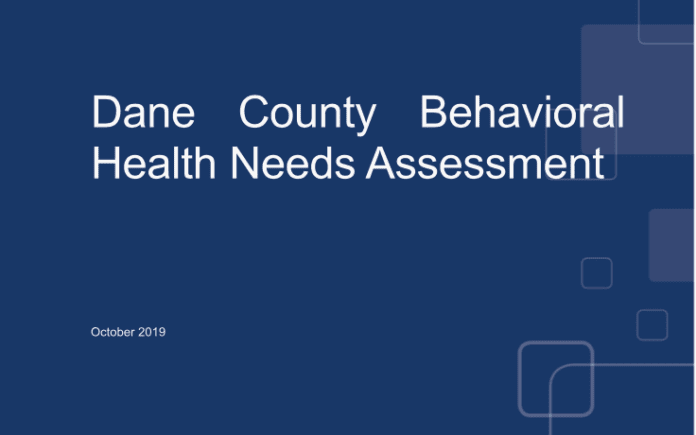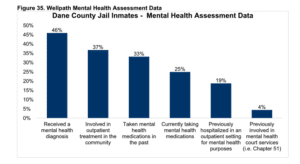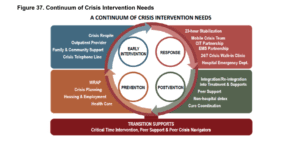Well, its 91 pages and still reading, but here’s some highlights! Here’s the main recommendations and some points of interest!
Here’s the full report (Dane County Behavioral Health Needs Assessment 10 22 19 v2) if you want to take a look!
WHAT THE REPORT WAS SUPPOSED TO COVER
This report addresses the following research topics, as outlined in PCG’s scope of work from DHS:
1. Service Accessibility, Effectiveness and Adequacy
- Wait times and contractual obligations
- Comparison to national and state outcomes
- Outcomes disparities across population demographics
2. Impact of law enforcement practices
3. Resources in lieu of incarceration and Chapter 51
4. Restorative justice interventions
RECOMMENDATIONS
1. Maximize capacity through better facility and provider coordination: Capacity analysis shows that some facilities are overutilized, while others are underutilized. PCG recommends conducting a root cause analysis to determine reasons underpinning lack of utilization for certain providers. After the root cause analysis, PCG recommends Dane County collaborates with Medicaid and commercial payers to centralize resource information and educate advocates, clients, and providers about all care options with the goal of using existing capacity more effectively;
2. Establish formal partnerships between providers and facilities: Formal relationships can ease the administrative burden of finding placements for individuals in need of various levels of care. Ensuring that providers and facilities have formal connections with partners across the continuum of care can also help reduce facility capacity issues;
3. Develop additional services to reduce gaps in crisis care: One notable gap within the continuum of care is the absence of 23-hour observation beds. These extended observation beds help reduce emergency room and inpatient care for behavioral health crises. Currently, crises that occur after hours in Dane County are largely managed by hospital Emergency Departments;
4. Improve access to care for underserved populations: PCG recommends that Dane County work with community organizations to create and implement a strategic plan to improve access to underserved populations. This should include identifying key resources, metrics, and outreach/in-reach strategies to effectively engage individuals in need and meet people where they are in their communities;
5. Increase diversion options: In Dane County, there are several diversion programs available across the behavioral health and criminal justice system intercepts, however few specifically focus on mental health. PCG recommends developing diversion models that are specifically focused on mental health and/or co-occurring disorders to include both a pre-arrest and post-arrest option;
6. Extend crisis response to rural areas: The Madison Police Department is a national example for law enforcement response to mental health crisis. However, the same practices are not duplicated across the county, specifically in rural areas. Outside of the Madison Police Department, only the Dane County Sheriff’s Office has a dedicated crisis worker, and that position is only half filled; and,
7. Create infrastructure for cross-sector, data-driven decision making: The current Memorandum of Understanding (MOU) Coordinated by the Criminal Justice Council (CJC) in Dane County does not include behavioral health providers. Dane County could benefit from including behavioral health providers as part of this MOU, specifically to better track frequent users of the criminal justice system who also have a mental health disorder.
NEED
The Wisconsin Department of Health Services (WDHS) estimates 77,563 adults in Dane County have experienced a mental health illness, 18.2 percent of the adult population. Serious mental illnesses (SMI) are defined as mental, behavioral, or emotional disorders that result in an impairment interfering or limiting one or more major life activities. WDHS estimates 16,505 adults in Dane County have experienced SMI. This accounts for 3.9 percent of Dane’s population. Nearly ten percent (9.45%) of persons over 12 years of age have experienced substance use disorder, with 41 percent of those individuals experiencing a co-condition of a mental health condition.
For youth, the WDHS estimates 16,557 children have experienced a mental illness, which represents 3% of total youth population. Serious emotional disturbance (SED) is the youth equivalent to SMI. In Dane County, 1.6% of children (8,673 children) have experienced a SED.
RACIAL DISPARITIES IN ACCESSING TREATMENT?
Looks like they have inadequate data. See pages 39 – 41
IMPACT OF LAW ENFORCEMENT?
Some points of interest . . . see pages 44 – 61
- Wellpath data from November 1, 2016 – August 31, 2017 shows there were approximately 8,700 inmates booked into Dane County jail, and of those, 46% had previously been diagnosed with a mental illness and 4% had previously been involved in court services related to their mental health issue, such as Chapter 51.
- A common theme throughout our stakeholder discussions was the lack of diversion options designed specifically for individuals with mental health issues, specifically related to pre-arrest diversion.
- While people with mental illness are not more prone to violence, it is common for law enforcement to be called when a person is experiencing a mental health crisis due to limited community health treatment options nationwide. Law enforcement agencies have reported that anywhere from five (5) to 15 percent of their annual calls involve an individual struggling with mental illness. 12 According to The Treatment Advocacy Center, people with untreated mental illness are 16 times more likely to be killed during a police encounter. 13 It is imperative for law enforcement and other first responders to have training on how to appropriately respond to a mental health crisis to help de-escalate the situation, reduce the risk of violence, and ultimately, improve outcomes for people suffering from mental illness.
- Currently, jails and prisons are the largest provider of mental health services in the country. A person suffering from mental illness is more likely to be encountered by police than to get medical help. According to NAMI, 15% of men and 30% of women booked into jails have a serious mental health condition and nearly 2 million people with mental illness are booked into jail each year.
- Another common theme was that Journey Mental Health Center and Tellurian operate several crisis intervention and stabilization programs; however, coordination and communication could be improved between the organizations.
- They suggest using mental health courts to provide restorative justice options. Restorative justice in specialty courts focuses on treatment options for an individual’s issues, which promotes the restoration of the offender. Working with specialty courts allows mental health counselors to combine individual therapy with vocational counseling, oversight of community service for program participants, aftercare supervision, and mediation and arbitration with victims to emphasize accountability for the individual impacting the restorative process for all stakeholders.
CRISIS RESTORATION CENTER ASSESSMENT
This section was a LOT shorter than I expected. pages 62 – 66. Most of it is spent listing current services and comparing the Tucson and San Antonio model. There seems to be no analysis of the results or recommendations from this section.
Again, here’s the full report (Dane County Behavioral Health Needs Assessment 10 22 19 v2) if you want to take a look!






